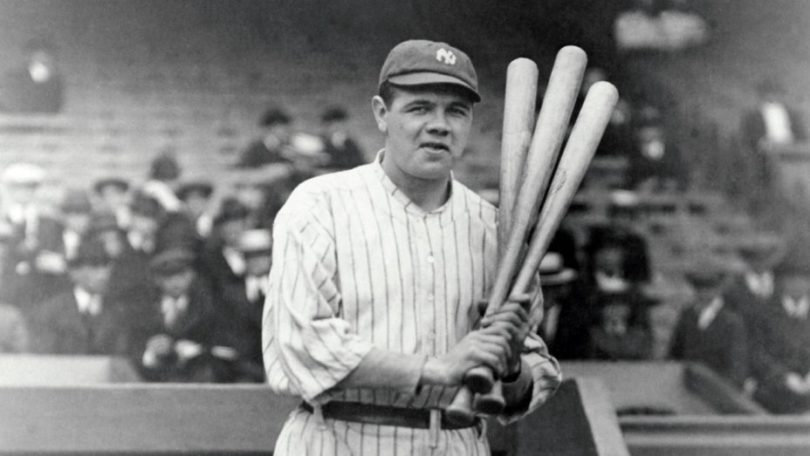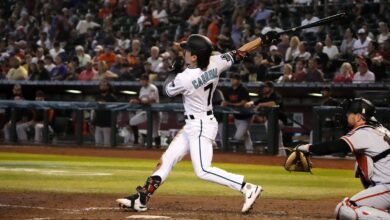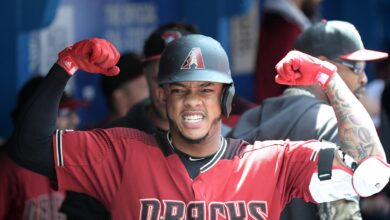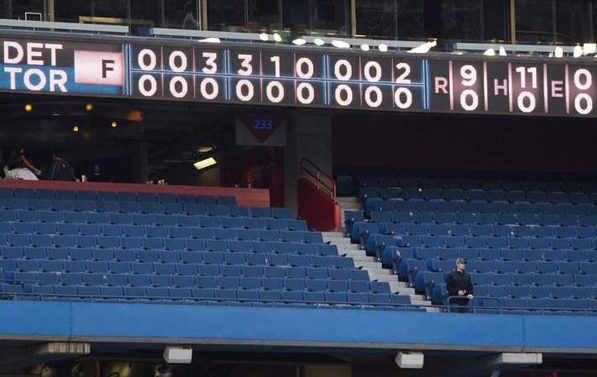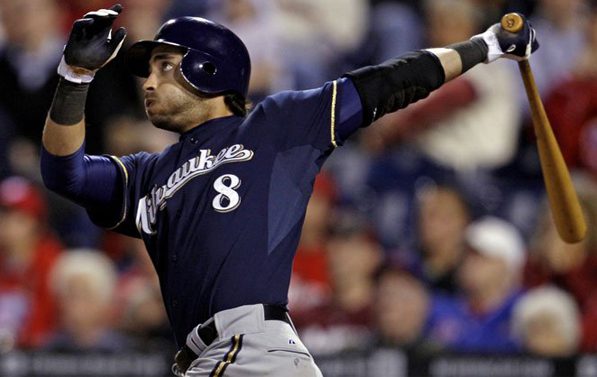

Welcome to the initial installment of Relaying the Signs, a weekly column dedicated to anything and everything surrounding the world of Major League Baseball.
Slightly more than one week ago, the Milwaukee Brewers broke the bank — as well as the franchise’s previous record for the largest contract ever awarded to a single player — when they extended the contract of outfielder Ryan Braun through the 2020 season. The deal also includes a mutual option for the 2021 season worth $20 million as well as a $4 million buyout clause. Overall, the extension totals $105 million over its five-year duration.
The deal has been received with nothing but positive sentiments by fans — which, seemingly, is understandable. After all, for the second time since 2007, the Brewers were able to announce a successful extension of one of the National League’s premiere hitters without having to painstakingly adhere to the restrictions or headaches that accompany free agency and arbitration processes. Clearly, Braun wants to remain in Milwaukee — a place where the off-the-field entrepreneur has opened a restaurant, started his own clothing line and can even routinely be seen courtside at Bucks games — and the city couldn’t be happier about it.
Elsewhere around the league, however, a few eyebrows have been raised regarding the deal. Perhaps justifiably so, upon further deliberation. The extension of Braun’s contract by Milwaukee’s front office is just the most recent in a trend of short-sighted decisions involving the misuse of the franchise’s internal talent and financial resources.
For the sake of historical perspective, Braun’s new deal is just the ninth contract to surpass $100 million dollars — in addition to an annual salary worth at least $20 million — ever signed in Major League Baseball.
Also, his $21 million per year is the second highest total ever awarded to an outfielder and only the third to ever touch the 20-million mark. The other two outfielders in this class are Carl Crawford, who signed with the Red Sox this winter to a seven-year deal worth $20 million annually, and Manny Ramirez, who agreed to a two-year deal with the Dodgers in 2009 worth $22.5 million per year. So, what makes the signing of outfielder Braun more venturesome than the two that preceded it? It’s not so much in regard to the money involved, although that conjures a little criticism in its own right. No, instead, it is certain circumstances surrounding the signing — both the length and timing of it — which makes it egregious, in a sense.
Let me first say that, yes, it is impossible to refute Braun’s prowess at the plate. He even makes an opposing team’s fans feel uneasy when he steps into the box. Now, imagine how pitchers feel.
Since his big-league debut in May of 2007, the University of Miami product has been one of the most consistent hitters in all of baseball and has the hardware to prove it. Since winning the National League Rookie of the Year Award in 2007, Braun has been elected to the All-Star Game and been awarded a Silver Slugger Award in three consecutive seasons (2008-10).

Braun, at least statistically speaking, is surrounded by some elite company when it comes to offensive production. For instance, he is one of only five players to ever collect at least 125 home runs while simultaneously hitting .300 or better during the first four seasons of a career. The other four players being Albert Pujols, Ted Williams, Chuck Klein and Joe DiMaggio — all of whom are, or will inevitably be, in the Hall of Fame.
Be that as it may, hitting is not all that is required within the confines of his new contract. Therein lies the issue — at least one of them, anyway.
These days, thanks in large part to modern day statistical analysis (namely, Bill James and the Society for American Baseball Research’s Sabermetrics), we fans are now able to assess with precision and accuracy just how good our favorite players are when it comes to even the most specific of talents or situations.
Suffice to say, information as detailed and easily accessible as that doesn’t bode well for someone like Braun in relation to his defensive abilities — or in his case, lack thereof.
Take, for instance, Ultimate Zone Rating (UZR), which is an advanced defensive metric that uses play-by-play data recorded by Baseball Info Solutions to estimate a player’s defensive contributions by way of theoretical runs that particular player is worth to his team relative to the average around the league at his position. In other words, the prototypical defensive player scores a zero; anything above that is considered good and vice-versa.
A topical side note: Fangraphs.com states that historically, evidently according to advanced statistics, baseball players’ defensive abilities begin to diminish by their mid-20s — almost universally.
Which brings me back to Braun, of course.
Every Milwaukee fan remembers when Braun played third base at Miller Park during his 2007 rookie season. Well, if you don’t, let’s just say that there’s a very calculated reason for his shift to left field. His UZR in 2007, when adjusted to reflect 150 games played, was a legendary -41.5 and is still considered one of the worst in the history of such statistical measurements.
Since moving to — or should I say, hiding in — left field the past few seasons, that negative number has shrunk considerably. However, after ranking just outside the bottom five of left fielders in 2010 with a score of -9.3, along with considerations for age regression, it wouldn’t at all be a stretch to expect him to finish at the very bottom of all left fielders here in 2011. After all, as of Tuesday, April 26th, he is on pace to finish around -35 for the season.
Not exactly numbers that typically warrant such an immense contract.
And then there’s this curious piece of information — the fact that Milwaukee had already contractually controlled Braun through 2015 at one of the league’s most recognized bargain prices, even before the extension. Yet, somehow having him locked into contract the remainder of this season and the four that follow — literally, in direct correlation to the typical prime age for MLB players (27-31-years-old) — at an annual salary roughly half that of his new extension, just wasn’t enough.
Instead, the Brewers and their general manager, Doug Melvin, saw enough from Braun in his four seasons to compel the small-market franchise into committing an unnecessary sum of money towards keeping Ryan until he retires. Consider that, beginning in 2016 and lasting half a decade, the organization will be obligated to pay a mid-30-year-old, who struggles defensively even now at the age of 27, around $20 million dollars to be a show at the plate but a liability in left field.
After all is said and done, Ryan Braun will owe his comfortable post-retirement lifestyle to his agent, Nez Balelo, who appears to have taken advantage of Milwaukee’s management. As it stood prior to the extension, Braun would have been 31 when he reached free agency. Balelo may have been able to find an American League team that, after the inevitable effect of inflation, would be willing to pay that sort of money for a designated hitter. There is even a decent chance he could have sought more. However, he was able to ensure that type of money later in Braun’s career regardless of what the future holds from both a health and effectiveness standpoint.
That’s wonderful insurance for Braun, but an unnecessary risk for the Brewers.
Assuming the team’s payroll pattern remains consistent leading up to that time period, Melvin will have slightly more than 20 percent of his entire payroll allotment devoted to one player who represents around three percent of the 40-man roster. So, he’ll have three percent of the roster, that only happens to only be good at 50 percent of its jobs, receiving an inordinate percentage of his payroll.

While Braun did generously agree to defer an undisclosed sum of money in order to help the team remain competitive, it might now be nearly impossible for this organization to do so in the not-so-distant future.
Following the completion of this season, Milwaukee will have at least $25-30 million dollars coming off the payroll, guaranteed. That is to assume the following: Prince Fielder opts for free agency; LaTroy Hawkins and Takashi Saito are not re-signed; the Brewers exercise Yuniesky Betancourt’s $2 million buyout clause ; as well as a few other scenarios involving smaller fish.
Now, take in account salary increases for some core players’ contracts — Yovani Gallardo, Rickie Weeks, Corey Hart and Braun — who collectively stand to make an increase of $13 million in 2012, and you see that the Brewers find themselves with very little money to assign some very crucial depth-chart vacancies entering next season.
After the ink dried on his new extension, Braun stated publicly that he truly believed he could become an even better player than he already is. For Milwaukee’s sake, let’s hope he’s implying an improvement on the defensive side of things. That, or he needs to develop a curveball.
On the other hand, that’s why each organization stockpiles talent in the minor leagues — to soften the imminent turnover in professional baseball. This is especially important to small-market teams like Milwaukee.
For example, the Florida Marlins won the 2003 World Series with a payroll just under $50 million while utilizing little-known homegrown talents like Dontrelle Willis and Miguel Cabrera, who combined to make a mere $600,000 that season.
So, according to that logic, the Brewers will be fine, right? Not necessarily. See, for Milwaukee in recent years, prospects don’t represent future investments, they are trade bait used to temporarily fill holes at the big league level.
When the team appeased fans by “renting” CC Sabathia for 2008’s playoff push, they did so at the cost of four promising young talents headlined by their top prospect at the time, a power-hitting first baseman named Matt LaPorta. Sabathia came [up short] before booking for free agency. Fans appreciated the gesture at the time as they enjoyed a rare playoff appearance, and the majority of them still defend Melvin’s decision to this day. Deep down, though, one can’t deny how convenient it would be having a future star like LaPorta waiting in the background for when Fielder is no longer around.
That’s what prospects are generally there for — to build the foundation of a winning team, not temporarily patch it up.
The Brewers again cleaned out the higher ranks of their system when they acquired pitchers Zack Greinke and Shaun Marcum this winter. Unlike with Sabathia, the Brewers will have each pitcher’s services through at least 2012, but it again cost them dearly — especially if they are unable to retain either Greinke or Marcum following the expiration of their current deals. Former first-round draft picks and top prospects, Brett Lawrie and Alcides Escobar, were the headliners in both deals. Although the need for Lawrie, a second baseman, is diminished by the semi-recent extension of Rickie Weeks’ contract, Escobar, a supremely talented shortstop, could certainly be of use to the big league club in the immediate future.
You’re probably thinking, “Wait, Ryan Braun was developed internally. Isn’t it a bit contradictory to suggest his extension as being negative?”
You’d be correct, if I were implying that the player involved was the main problem in this particular case. Instead, it is more so the parameters and timeliness of the deal that are off-putting, although Braun’s troubling defense make a compelling case that he should be considered the biggest problem.
As of now, the Milwaukee Brewers have an extremely unpromising pool of young players in their system and a lot of vacancies to address at Miller Park in a short time. The trades vaguely outlined above are nothing but quick fixes to a problem that continues to become increasingly imminent. Unfortunately, the recent moves, which will likely be regrettable in retrospect, are going unrecognized by most fans.
And who could blame them? When you’re team has just two postseason appearances in the history of the franchise — one of which is only remembered by those ages 40 and above — any attempt to make a blockbuster acquisition is automatically received in a positive light, regardless of how depleting it may be to what should be the foundation of the franchise.
The key to success, often times, is knowing your limitations.
Without the financial resources or franchise appeal that other large-market teams have to offer, benefiting from a fruitful farm system is a must for teams like the Milwaukee Brewers. Unfortunately, it takes many years to construct a foundation of youth through amateur drafting and international scouting, and only a fraction of the time to destroy it via questionable trades and contract agreements. Even more unfortunate, is the fact that a franchise with just one playoff appearance in almost 30 years has yet to grasp that concept, and fans may have to get used to just 162 games each season.


